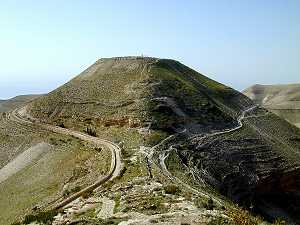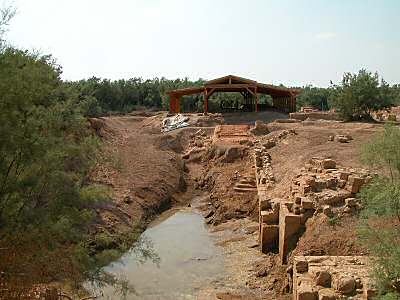Day 7
John the Baptist
She went out and said to her mother, "What shall I ask for?" "The head of John the Baptist," she answered. Mark 6:24
Machareus (Mukawir)
(click on the photo below for a LARGER view)

Modern Mukawir in Jordan is Machaerus of biblical times. At the time of the Maccabean Revolt, the Hasmonaean dynasty had set up a powerful Jewish state east and west of the Jordan River. They built a number of forts to protect their territory, one of which was Machaerus in the east, another was Masada in the west. Herod the Great later captured this region, and launched an ambitious construction campaign that included a great palace at Machaerus. After Herod the Great died, Machaerus passed on to his son Herod Antipas.
This site is best known as the place where Herod had John the Baptist beheaded, as recounted in the gospels of Matthew and Luke. The people of the region considered John the Baptist a holy man and prophet, but John was preaching against Herod Antipas and Herodias, because their marriage violated the law. Herod arrested John, imprisoned him in Mukawir, but did not kill him for fear of retribution from the people. Later, during a celebration at the palace, Herodias’ daughter Salome danced for Herod, who was so pleased that he promised to give Salome anything she wanted. Herodias, angry at John’s condemnation, prompted her daughter to ask for John’s head, and Herod felt obliged to honor his word. So thus ends the story of John the Baptist – dying because of his faith.
Later we visited Bethany beyond the Jordan
(Al-Maghtas in Wadi Kharrar)
 "This happened at Bethany, beyond the Jordan, where John [the Baptist] was baptizing."
"This happened at Bethany, beyond the Jordan, where John [the Baptist] was baptizing." This is especially significant because many biblical scholars believe John to be the most precise of the gospel writers, using more factual detail in his account of the events in Jesus’ life
(cf. John 5:2 and 19:13).
Interestingly, when John mentions another Bethany in the story of Lazarus (John 11:1-44), he is careful to distinguish this second Bethany from the first by describing it as "…only two miles from Jerusalem," clearly not the baptism site. A further indication of the authenticity of Al-Maghtas as the baptism site is its identification as both the place of John the Baptist’s ministry (John 10:40) and the site of Elijah’s being taken up to heaven in a chariot of fire (2 Kings 2:5-14). Both John the Baptist and Elijah played the roles of prophet and precursor to the messianic time, and Matthew (17:10-13) explicitly identifies John with Elijah.
Recent excavations at Al-Maghtas have located Bethany on the east bank of the Jordan River. Independent archeological teams and experts confirm this conclusion, and the Roman Catholic Church has placed Al-Maghtas on the list of five official pilgrimage sites in Jordan. Both St. Jerome and the 4th century historian Eusebius identify Al-Maghtas as an integral part of the early Christian pilgrimage route between Jerusalem and Mount Nebo. It also appears in Madaba on the oldest mosaic map in the world.
Among the discoveries in the original settlement at Al-Maghtas are seven churches from the 1st century, as well as remains of many Byzantine churches from later centuries.
John the Baptist – the forunner for Jesus. In what ways are we preparing the way for others to come to know Jesus? More important, are we willing to pay the price to do this?
Prayer
Jesus, help me always to be thinking of ways in which I can introduce others to you – no matter what the cost. Amen
Did someone send you this Devotion? Would you like to receive future ones directly?
Click here to subscribe. While in the Middle East for a Biblical Study Journey with fellow Word Among Us Students, a 5-person crew is filming and taking pictures of the various sites. This vibrant photographic material will be incorporated into next year's Word Among Us classes.
Want to learn more about the Bible Jesus used – The Old Testament – and the Bible Jesus taught? Enroll today in Word Among Us – Cover to Cover study of the Bible starting in Genesis and going through Revelation including the inter - testamental period, using history and archeology and Biblical culture to make the text alive - taught by Tim Hetzner.
Class sites are across the USA. Click here for more information.
 Modern Mukawir in Jordan is Machaerus of biblical times. At the time of the Maccabean Revolt, the Hasmonaean dynasty had set up a powerful Jewish state east and west of the Jordan River. They built a number of forts to protect their territory, one of which was Machaerus in the east, another was Masada in the west. Herod the Great later captured this region, and launched an ambitious construction campaign that included a great palace at Machaerus. After Herod the Great died, Machaerus passed on to his son Herod Antipas.
Modern Mukawir in Jordan is Machaerus of biblical times. At the time of the Maccabean Revolt, the Hasmonaean dynasty had set up a powerful Jewish state east and west of the Jordan River. They built a number of forts to protect their territory, one of which was Machaerus in the east, another was Masada in the west. Herod the Great later captured this region, and launched an ambitious construction campaign that included a great palace at Machaerus. After Herod the Great died, Machaerus passed on to his son Herod Antipas.  "This happened at Bethany, beyond the Jordan, where John [the Baptist] was baptizing." This is especially significant because many biblical scholars believe John to be the most precise of the gospel writers, using more factual detail in his account of the events in Jesus’ life (cf. John 5:2 and 19:13).
"This happened at Bethany, beyond the Jordan, where John [the Baptist] was baptizing." This is especially significant because many biblical scholars believe John to be the most precise of the gospel writers, using more factual detail in his account of the events in Jesus’ life (cf. John 5:2 and 19:13).

0 Comments:
Post a Comment
<< Home